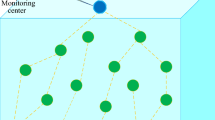Abstract
Underwater acoustic sensor network (UWASN) has recently aroused the interest of researchers and scientists in this field. The acoustic sensor bandwidth is limited in underwater and it causes low successful packet transmission. One of the methods to overcome this handicap is efficient broadcast scheduling of underwater acoustic sensor node (UASN) that would help in transmitting and receiving data without any collision. This can be done with the help of time division multiple access (TDMA). The basic idea is to address broadcast scheduling problem in UWASN for utilizing the limited available bandwidth by parallelizing the node transmission such that it does not interfere with each other in same time slot; it also minimizes the node turnaround transmission time in the network by optimizing the time slots in TDMA frame. The objective of this paper is to maximize the utilization of the available underwater acoustic bandwidth and to achieve high throughput as well as to reduce the node turnaround wait time by using an evolutionary genetic algorithm (GA). The simulation results prove that every node in the UWASN transmits in an average minimal turnaround time by minimizing the time slots and maximizing the throughput in the network by scheduling the possible nodes with parallel transmission.










Similar content being viewed by others

References
https://www.popsci.com/article/technology/underwater-gliders-gather-data-help-predict-next-big-storm. Accessed 19 Sep 2016
Che X, Wells I, Dickers G, Kear P, Gong X (2010) Re-evaluation of RF electromagnetic communication in underwater sensor networks. IEEE Commun Mag 48(12):143–151
Farr N, Bowen A, Ware J, Pontbriand C, Tivey M (2010) An integrated, underwater optical/acoustic communications system. IEEE OCEANS Sydney, pp 16
Heidemann J, Stojanovic M, Zorzi M (2012) Underwater sensor networks: applications, advances and challenges. Philos Trans R Soc 370:158–175
Akildiz IF, Pompili D, Melodia T (2005) Underwater acoustic sensor networks: research challenges. Ad Hoc Networks 3:257–279
Akyildiz IF, Wang P, Lin S-C (2016) SoftWater: software-defined networking for next-generation underwater communication systems, Ad Hoc Networks
Hong L, Hong F, Guo Z, Li Z (2011) ECS: Efficient Communication Scheduling for underwater sensor networks. Sensors 11(3):2920–2938
Pu L, Luo Y, Mo H, Peng Z, Cui J-H, Jiang Z (2013) Comparing underwater MAC protocols in real sea experiment, IFIP Networking Conference
Partan J, Kurose J, Levine BA (2006) A survey of practical issues in the underwater networks, International conference on Mobile computing and Networking (Mobicom), Los Angeles, CA, USA Sep (2006)
Akyildiz IF, Pompili D, Melodia T (2006) State of the art in protocol research for underwater acoustic sensor networks, ACM International workshop on underwater networks (WUWNet), Los Angeles, CA, USA Sep (2006)
Xie P, Cui JH (2006) Exploring random access and handshaking techniques in large-scale underwater wireless acoustic sensor networks, OCEANS
Climent S, Sanchez A, Capella JV, Meratnia N, Serrano JJ (2014) Underwater acoustic wireless sensor networks: advances and future trends in physical, MAC and routing layers. Sensors 14(1):795–833
Hong L, Hong F, Guo Z, Li Z (2011) ECS: efficient communication scheduling for underwater sensor networks. Sensors 11:2920–2938
Chitre M, Shahabodeen S, Stojanovic M (2008) Underwater acoustic communications and networking: recent advances and future challenges. Mar Technol Soc J 42:103–116
Huang P-H, Chen Y, Krishnamachari B (2010) Anilkumar, Link scheduling in a single broadcast domain underwater network, IEEE International Conference on Sensor Networks, Ubiquitous and Trust worth computing (SUTC), Newport Beach, CA, USA June (2010), pp. 205–212
Lee JW, Cho HS (2014) Cascading multi-hop reservation and transmission in underwater acoustic sensor networks. Sensors 14:18390–18409
Diamant R, Lampe L (2011) Spatial reuse TDMA for broadcast ad-hoc underwater acoustic communication networks. IEEE J Ocean Eng 36:172–185
Bharathi C, Rekha D, Vijayakumar V (2017) Genetic algorithm based demand side management for smart grid. Wirel Pers Commun 93:481–502
Sivakumar V, Rekha D (2018) Underwater acoustic sensor node scheduling using an evolutionary memetic algorithm. Res J Telecommun Inf Technol 1:88–94
Hong L, Hong F, Guo Z, Yang X (2008) A TDMA-based MAC protocol in Underwater Sensor Networks, IEEE conference on wireless communication, Networking and Mobile Computing (Wicom) Oct (2008), pp. 1–4
Anjangi P, Chitre M (2015) Design and implementation of super TDMA: a MAC protocol exploiting large propagation delays for underwater acoustic networks, ACM International Conference on Underwater Networks and System (WUWNET),Washington DC, USA, Oct (2015)
Kredo K, Djukic P, Mohuputra P (2009) STUMP: exploiting position diversity in the staggered TDMA underwater MAC protocol, IEEE conference on computer communications (Infocom), Rio De Janeiro, Brazil, Apr (2009)
Hsu C-C, Lai K-F, Chou C-F, Lin K C-J (2009) ST-MAC: spatial-temporal MAC scheduling for underwater sensor networks. In: Proceedings of IEEE InfoCom, Rio de Janeiro, Brazil, 1925, pp. 1827–1835
David E (1997) Goldberg, genetic algorithms in search. Optimization and machine learning. Addison Wesley
De Jong KA, Spears WM (1989) Using genetic algorithm to solve NP-complete problems, Proceedings of 3rd International Conference on Genetic Algorithms Jan (1989), pp. 124–132
Author information
Authors and Affiliations
Corresponding author
Rights and permissions
About this article
Cite this article
Sivakumar, V., Rekha, D. Node scheduling problem in underwater acoustic sensor network using genetic algorithm. Pers Ubiquit Comput 22, 951–959 (2018). https://doi.org/10.1007/s00779-018-1136-3
Received:
Accepted:
Published:
Issue Date:
DOI: https://doi.org/10.1007/s00779-018-1136-3



